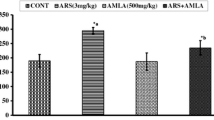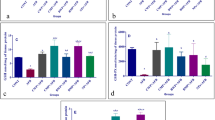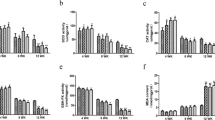Abstract
Arsenic is a toxic heavy metal widely found in the natural environment and has adverse effects on the health of waterfowl and human. Curcumin (CUR), a natural pigment of the golden spice turmeric, exhibits excellent anti-tumor, anti-inflammatory and anti-oxidant activities. But the effects of CUR on duck spleen exposed to arsenic remain largely unknown. In this study, 75 ducks were divided randomly into Control, L-ATO, M-ATO, H-ATO and CUR + H-ATO groups to systematically analyze the underlying role of CUR. The results showed that arsenic trioxide (ATO) led to growth retardation of ducks, hyaline degeneration and sparse cell arrangement on their spleen. And in the ATO-exposed ducks, the levels of immunoglobulins (Ig; IgA, IgG, IgM) in the serum and the expression of autophagy-related genes (Atg5, P62, LC3I, LC3II, LC3II/I, Beclin-1) were significantly upregulated compared with the control ducks. Moreover, ATO also activated NF-κB signal pathway and upregulated the expression of pro-inflammatory cytokines (TNF-α, IFN-γ, IL-1β, IL-2, IL-18). Meanwhile, application of CUR alleviated the ATO toxicity with the release of growth inhibition, and the reduced hyaline degeneration and distortion of the spleen capsule. CUR also suppressed ATO-induced NF-κB activation, pro-inflammatory cytokine addition and expression of autophagy-related genes. Overall, these results suggested that CUR might exert a protective effect against ATO-induced immunosuppression in ducks via anti-inflammation and autophagy restoring.
Graphical abstract








Similar content being viewed by others
References
Abdel-Daim MM, Abo-El-Sooud K et al (2018) Alleviation of drugs and chemicals toxicity: biomedical value of antioxidants. Oxid Med Cell Longev 2018:6276438
Bahrami A, Sathyapalan T et al (2020a) Counteracting arsenic toxicity: curcumin to the rescue? J Hazard Mater 400:123160
Bahrami A, Sathyapalan T et al (2020b) Counteracting arsenic toxicity: curcumin to the rescue? J Hazard Mater 400:123160
Burge K, Gunasekaran A et al (2019) Curcumin and intestinal inflammatory diseases: molecular mechanisms of protection. Int J Mol Sci 20(8)
Choudhury S, Ghosh S et al (2016) Pomegranate protects against arsenic-induced p53-dependent ROS-mediated inflammation and apoptosis in liver cells. J Nutr Biochem 38:25–40
Cordero H, Morcillo P et al (2018) Inorganic arsenic causes apoptosis cell death and immunotoxicity on European sea bass (Dicentrarchus labrax). Mar Pollut Bull 128:324–332
Deretic V, Saitoh T et al (2013) Autophagy in infection, inflammation and immunity. Nat Rev Immunol 13(10):722–737
Duan X, Gao S et al (2017) Acute arsenic exposure induces inflammatory responses and CD4(+) T cell subpopulations differentiation in spleen and thymus with the involvement of MAPK, NF-kB, and Nrf2. Mol Immunol 81:160–172
Fang Y, Xing C et al (2021) Activation of the ROS/HO-1/NQO1 signaling pathway contributes to the copper-induced oxidative stress and autophagy in duck renal tubular epithelial cells. Sci Total Environ 757:143753
Gelfand EW (2012) Intravenous immune globulin in autoimmune and inflammatory diseases. N Engl J Med 367(21):2015–2025
Hull EA, Barajas M et al (2021) Human health risk from consumption of aquatic species in arsenic-contaminated shallow urban lakes. Sci Total Environ 770:145318
Jamal Z, Das J et al (2020) Arsenic-induced immunomodulatory effects disorient the survival-death interface by stabilizing the Hsp90/Beclin1 interaction. Chemosphere 238:124647
Jiang X, Yu W et al (2021) Arsenic (III) and/or Antimony (III) induced disruption of calcium homeostasis and endoplasmic reticulum stress resulting in apoptosis in mice heart. Ecotoxicol Environ Saf 220:112394
Kim JH, Kang JC (2016) The immune responses and expression of metallothionein (MT) gene and heat shock protein 70 (HSP 70) in juvenile rockfish, Sebastes schlegelii, exposed to waterborne arsenic (As(3+)). Environ Toxicol Pharmacol 47:136–141
Levine B, Mizushima N et al (2011a) Autophagy in immunity and inflammation. Nature 469(7330):323–335
Levine B, Mizushima N et al (2011b) Autophagy in immunity and inflammation. Nature 469(7330):323–335
Liu J, Zhao H et al (2018) Impacts of simultaneous exposure to arsenic (III) and copper (II) on inflammatory response, immune homeostasis, and heat shock response in chicken thymus. Int Immunopharmacol 64:60–68
Liu J, Wang Y et al (2020) Arsenic (III) or/and copper (II) exposure induce immunotoxicity through trigger oxidative stress, inflammation and immune imbalance in the bursa of chicken. Ecotoxicol Environ Saf 190:110127
Matucci A, Maggi E et al (2014) Mechanisms of action of Ig preparations: immunomodulatory and anti-inflammatory effects. Front Immunol 5:690
Moscat J, Diaz-Meco MT (2009) p62 at the crossroads of autophagy, apoptosis, and cancer. Cell 137(6):1001–1004
Osman A, ElFar A et al (2017) Immunity, antioxidant status, and performance of broiler chickens fed turmeric (Curcuma longa) rhizome powder. Alexandria J Veterinary Sci 54(2)
Saha S, Sadhukhan P et al (2018) Ameliorative role of genistein against age-dependent chronic arsenic toxicity in murine brains via the regulation of oxidative stress and inflammatory signaling cascades. J Nutr Biochem 55:26–40
Salehi B, Stojanovic-Radic Z et al (2019) The therapeutic potential of curcumin: a review of clinical trials. Eur J Med Chem 163:527–545
Sanchez-Virosta P, Espin S et al (2020) Arsenic-related oxidative stress in experimentally-dosed wild great tit nestlings. Environ Pollut 259:113813
Sarkar S, Greenleaf JE et al (2012) Sustainable engineered processes to mitigate the global arsenic crisis in drinking water: challenges and progress. Annu Rev Chem Biomol Eng 3:497–517
Sharma RA, Gescher AJ et al (2005) Curcumin: the story so far. Eur J Cancer 41(13):1955–1968
Tabeshpour J, Banaeeyeh S et al (2019) Effects of curcumin on ion channels and pumps: a review. IUBMB Life 71(7):812–820
Trujillo J, Chirino YI et al (2013) Renoprotective effect of the antioxidant curcumin: recent findings. Redox Biol 1:448–456
Wang C, Nie G et al (2020a) Molybdenum and cadmium co-induce oxidative stress and apoptosis through mitochondria-mediated pathway in duck renal tubular epithelial cells. J Hazard Mater 383:121157
Wang J, Zhang G et al (2020b) Determination of arsenicals in mouse tissues after simulated exposure to arsenic from rice for sixteen weeks and the effects on histopathological features. Ecotoxicol Environ Saf 200:110742
Wang Y, Zhao H et al (2021) Zinc offers splenic protection through suppressing PERK/IRE1-driven apoptosis pathway in common carp (Cyprinus carpio) under arsenic stress. Ecotoxicol Environ Saf 208:111473
Wei S, Qiu T et al (2020) Arsenic induces pancreatic dysfunction and ferroptosis via mitochondrial ROS-autophagy-lysosomal pathway. J Hazard Mater 384:121390
Wu S, Zhong G et al (2021) Evaluation of toxic effects induced by arsenic trioxide or/and antimony on autophagy and apoptosis in testis of adult mice. Environ Sci Pollut Res Int 28(39):54647–54660
Wu X, Guan R et al (2020) Comparative health risk assessment of realgar and NiuHuangJieDu tablets based on tissue arsenic levels after multiple oral administration to rats. J Ethnopharmacol 249:112370
Xue L, Zhao Z et al (2020) Dietary exposure to arsenic and human health risks in western Tibet. Sci Total Environ 731:138840
Yan N, Xu G et al (2020) Chronic arsenic exposure induces the time-dependent modulation of inflammation and immunosuppression in spleen. Cell Biosci 10:91
Yang S, Qiang L et al (2017) NF-kappaB signaling activation induced by chloroquine requires autophagosome, p62 protein, and c-Jun N-terminal kinase (JNK) signaling and promotes tumor cell resistance. J Biol Chem 292(8):3379–3388
Zhang C, Lin T et al (2021) In vivo assessment of molybdenum and cadmium co-induce nephrotoxicity via causing calcium homeostasis disorder and autophagy in ducks (Anas platyrhyncha). Ecotoxicol Environ Saf 230:113099
Zhao H, Wang Y et al (2018a) Subchronic arsenism disorders mRNA expression of cytokines and immunoglobulins in the intestinal tract of the cock. Biol Trace Elem Res 182(1):111–118
Zhao H, Wang Y et al (2018b) Subchronic arsenism disorders mRNA expression of cytokines and immunoglobulins in the intestinal tract of the cock. Biol Trace Elem Res 182(1):111–118
Zhao Y, Su X et al (2019) Exposure of low-concentration arsenic-initiated inflammation and autophagy in rat lungs. J Biochem Mol Toxicol 33(7):e22334
Zhong G, Wan F et al (2021a) Arsenic exposure induces intestinal barrier damage and consequent activation of gut-liver axis leading to inflammation and pyroptosis of liver in ducks. Sci Total Environ 788:147780
Zhong G, Wan F et al (2021b) The protective role of autophagy against arsenic trioxide-induced cytotoxicity and ROS-dependent pyroptosis in NCTC-1469 cells. J Inorg Biochem 217:111396
Zhong G, Wan F et al (2021c) The protective role of autophagy against arsenic trioxide-induced cytotoxicity and ROS-dependent pyroptosis in NCTC-1469 cells. J Inorg Biochem 217:111396
Zhuang J, Nie G et al (2021) Inhibition of autophagy aggravates molybdenum-induced mitochondrial dysfunction by aggravating oxidative stress in duck renal tubular epithelial cells. Ecotoxicol Environ Saf 209:111771
Availability of data and material
All relevant data and materials are available from the authors upon reasonable request.
Code availability
Not applicable.
Funding
This work was supported by the National Natural Science Foundation of China (#31402264); Guangxi Science and Technology Bureau (Gui Ke AA17204057, AA18118051); Program of Department of Natural Resources of Guangdong Province (GDNRC[2021]53); Projects of International Cooperation and Exchanges [NSFC(321611603)].
Author information
Authors and Affiliations
Contributions
Study design: FW, GZ, SW, XJ; experimental studies and data analysis: LT, LJ, SW, XJ; manuscript editing: LT, NZ; manuscript modification: ZT, RH, QP.
Corresponding author
Ethics declarations
Ethics approval
All animal procedures and experimental methods in this research were authorized by the Ethics Committee of South China Agricultural University. The treatment of animals in all experiments conforms to the ethical standards of experimental animals.
Consent to participate
Not applicable
Consent for publication
Not applicable
Conflict of interest
The authors declare no competing interests.
Additional information
Responsible Editor: Mohamed M. Abdel-Daim
Publisher’s note
Springer Nature remains neutral with regard to jurisdictional claims in published maps and institutional affiliations.
Supplementary Information
ESM 1
(DOCX 14 kb)
Rights and permissions
About this article
Cite this article
Tang, L., Lan, J., Jiang, X. et al. Curcumin antagonizes inflammation and autophagy induced by arsenic trioxide through immune protection in duck spleen. Environ Sci Pollut Res 29, 75344–75355 (2022). https://doi.org/10.1007/s11356-022-20691-3
Received:
Accepted:
Published:
Issue Date:
DOI: https://doi.org/10.1007/s11356-022-20691-3




